MP Board Class 12th Biology Solutions Chapter 5 Principles of Inheritance and Variation
Principles of Inheritance and Variation NCERT Textbook Questions and Answers
Question 1.
Mention the advantage of selecting pea plant for experiment by MendeL
Answer:
Advantages of selecting pea plant:
- Pea plant showed visible contrasting characters, e.g., seed colour, texture, plant height, flower colour, etc, it was easy to track the passing on of these characters in the progeny.
- The pea flower remains closed and stamens and carpel are both present on the same flower. Therefore, it undergoes self-pollination and breeds true for traits (no mixing of gene pool).
- It was easy to manipulate cross-pollination.
- Many offspring’s produced in one generation.
- Pea plant has short life cycle.
- It is easy to grow.
Question 2.
Differentiate between the foifowing:
(a) Dominance and Recessive
(b) Homozygous and Heterozygous
(c) Monohybrid andDihybrid.
Answer:
(a) Dominance and Recessive:
When a cross is made between single pair of contrasting characters then the character one which expresses itself phenotypically in F1 generation is known as dominant whereas other allele or trait which fails to express itself is recessive, e.g., when cross is made between two plants of pea, one having pure red flowers (RR) and other having pure white flowers (rr). In F1 generation only red-flowered has appeared.

(b) Differences between Homozygous and Heterozygous:
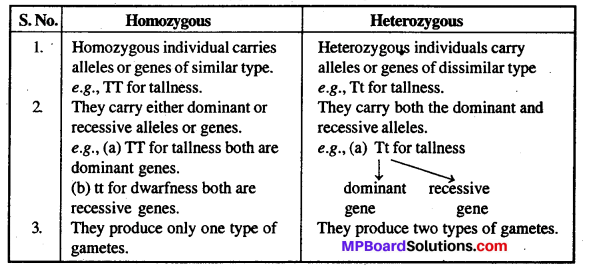
(c) Differences between Monohybrid cross and Dihybrid cross:

Question 3.
A diploid organism is heterozygous for 4 loci, how many types of gametes can be produced?
Answer:
Here, we apply the formula 2n where, n = number of loci. The organism is heterozygous for 4 loci
n=4
So, 2n = 24 = 2 × 2 × 2 × 2 = 16
The organism will produce 16 types of gametes.
Question 4.
Explain the law of Dominance using a monohybrid cross.
Answer:
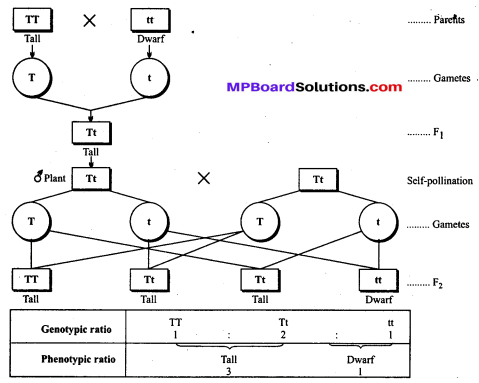
Monohybrid cross : Crossing between single pair of contrasting character, is known as monohybrid cross, e.g., hybridization between tall and dwarf plant of pea. All offspring of F1 generation of this cross will be tall. In F2 generation tall, hybrid tall and dwarf plants are produced in the ratio of 1:2:1. Thus, the genotypic ratio will be 1 TT: 2 Tt: 1 tt (1:2:1). The phenotypic ratio of F2 generation will be 3 : 1 (3TTand 1tt).
![]()
Question 5.
Define and design a test-cross.
Answer:
Crossing of F1 individual having dominant phenotype with its homozygous recessive parent is called test cross. The test cross is used to determine whether the individuals exhibiting dominant character are homozygous or heterozygous.
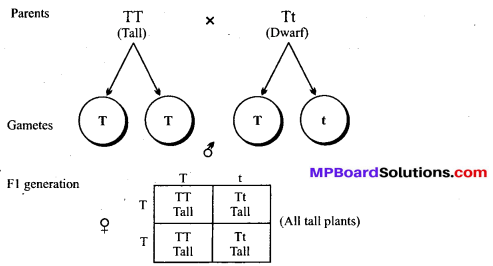
Question 6.
Using a punnett square, workout the distribution of phenotypic features in the first filial generation after a cross between a homozygous female and a heterozygous male for a single locus. .
Answer:
A cross between a homozygous female and heterozygous male follow two conditions :
Condition (1) : Homozygous female – TT (Tall)
Heterozygous male – Tt (Tall)
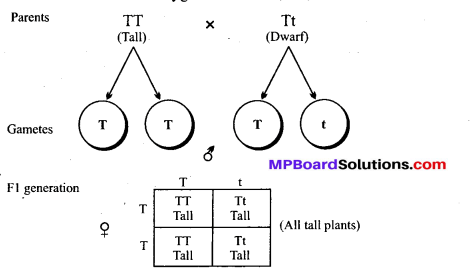
Condition (2) : Homozygous female – tt (dwarf)
Heterozygous male – Tt (Tall)
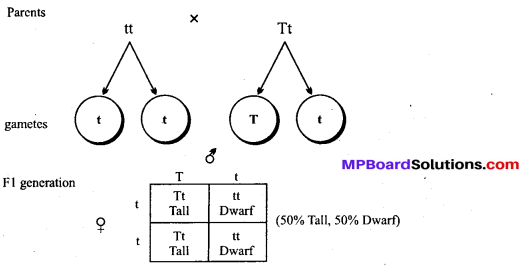
Question 7.
When a cross is made between tall plant with yellow seed (TtYy) and tall plant with green seed (Ttyy), what proportion of phenotype in the offspring could be expected to be:
(a) Tall and green
(b) Dwarf and green.
Answer:
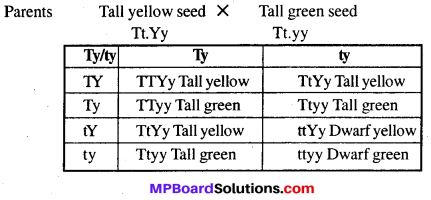

Question 8.
Two heterozygous parents are crossed. If the two loci are linked what would be the distribution of phenotypic features in F1 generation for a dihybrid cross.
Answer:
In case two heterozygous parents, showing linkage result will be :
Parents BbLl × Bb Ll
Genotype : Blue long Blue long
Phenotype In F1 all the combinations may show parental characters as the genes are completely linked. With all possible genotypes in Fj progeny may exhibit blue long type of phenotype in above case. However in case of incomplete linkage parental combinations will be less in number.
Question 9.
Briefly mention the contribution of T.H. Morgan in genetics.
Answer:
T.H. Morgan (1866-1945) was given the Nobel prize. His contributions are:
- Morgan worked on fruit fly Drosophila melanogaster and proposed the chromsomal theory of linkage.
- He stated and established that genes are located on the chromosome.
- He established the principle of linkage, crossing over, sex-linked inheritance and discovered the relationship between gene and chromosome.
- He established the technique of chromosome mapping.
- He observed and worked on mutation.
![]()
Question 10.
What is pedigree analysis ? Suggest how such an analysis can be useful.
Answer:
1. Pedigree analysis is an important method to study human genetics because :
- Human beings cannot be crossed at will.
- The generation time is very long (about 20 years).
- The number of offspring produced is small.
2. For pedigree analysis, information about the family’s history for a particular trait is first collected.
3. The expression of the trait is constructed in the form of a family tree.
4. In a pedigree, by convention :
- Circles denote females.
- Squares denote males.
- Solid symbols represent the trait being studied.
- Open symbols denote normal form.
- Symbol with a cross line indicates a carrier for a recessive trait.
- Parents are joined by horizontal lines.
- The offsprings are connected to a horizontal line below the parents in the order of birth and the line is
- connected to the parental line by a vertical line.
5. Pedigree analysis can yield valuable information about the possible genetic make up of a person for a trait.
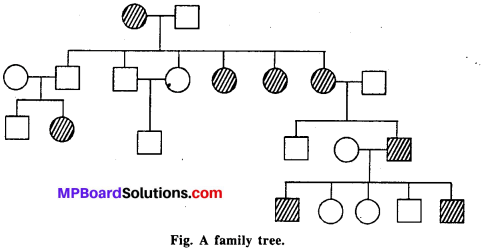
Functions : From pedigree analysis, we can find out, what kind of characters a new born baby is having. If this practice is done before marriage, we can be safe from many problems. It helps in finding the solution of hereditary problems.
Question 11.
How is sex-determined in human beings?
Answer:
Each cell of human beings contains 23 pairs of chromosomes. Out of 23 pairs, 22 pairs are similar and called as autosomes whereas 23rd pair is different from autosomes which are called as sex-chromosomes because they play important role in the determination of sex. In the cells of man, there are two types of sex chromosomes (XY) present while the cells of women have two similar sex chromosomes (XX). After spermatogenesis two types of sperms are formed, (i) One having 22 + X chromosomes and (ii) Other having 22 + Y chromosomes. But in woman there is only one type of ovum formed which contains 22 + X chromosomes only. At the time of fertilization when a sperm having 22 + X chromosomes is fused with ovum they produce a female child having two ‘XX’ chromosomes. But when a sperm having 22 + Y chromosomes is fused with ovum then resulting offspring will contain ‘XY’ sex chromosomes hence, it is male child.
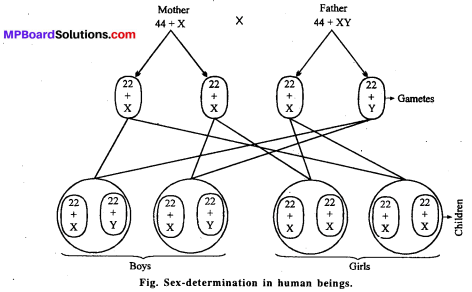
Question 12.
A child has blood group ‘O’. If the father has blood group ‘A’ and mother blood group ‘B’. Workout the genotypes of the parents and the possible genotypes of the other off springs.
Answer:
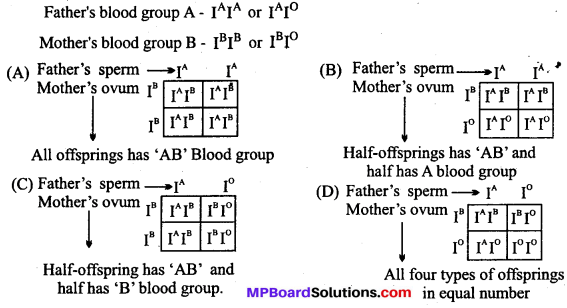
Question 13.
Explain the following terms with example:
(a) Co-dominance
(b) Incomplete dominance.
Answer:
(a) Co-dominance : When the F1 generation resembles both the parents and both the parental characters are expressed simultaneously, then a phenomenon is called co-dominance.
For example: ‘AB’ type blood group is possible when allele ‘A’ and ‘B’ come together and since, both the alleles are expressing their effects in F1 generation, they are co-dominants.
(b) Incomplete dominance : It is a condition which occurs between dominant alleles in which one may be slightly more dominant than the other.
Example : As in Mirabilis jalapa if a red flowered plant is crossed with white flowered plant, then the resulting F1 hybrid bears pink coloured flowers only. This intermediate inheritance is called incomplete dominance. The F1 pink flowered plants when self-pollinated, give F2 progeny which contains red, pink and white flowers in the ratio of 1 : 2 : 1. The phenotypic and genotypic ratio is same in case of incomplete dominance.
Question 14.
What is point mutation ? Give one example.
Answer:
Point mutation is a gene mutation that arises due to change in a single base pair of DNA.
Example : Sickle-cell anaemia.
A substitution of a single nitrogen base at the sixth codon of the β- globin chain of haemoglobin molecule causes the change in the shape of the R.B.C. from biconcave disc to elongated shaped, structure which results is sickle cell anaemia.
![]()
Question 15.
Who has proposed the chromosomal theory of inheritance?
Answer:
In 1902 Walter Sutton and Theodor Boveri proposed the ‘Chromosomal theory of inheritance’.
Question 16.
Mention any two autosomal genetic disorders with their symptoms.
Answer:
Phenylketonuria : This inborn error of metabolism is also inherited as the autosomal recessive trait. The affected individual lacks an enzme that converts the amino acid phenylalanine into tyrosine. As a result, this phenylalanine is accumulated and converted into phenyl pyruvic acid and other derivatives. Accumulation of these in brain results in mental retardation.
Sickle cell anaemia : This is an autosome liked recessive trait that can be transmitted from parents to the offspring when both the partners are carrier for the gene of heterozygous.
Principles of Inheritance and Variation Other Important Questions and Answers
Principles of Inheritance and Variation Objective Type Questions
Question
1. Choose the Correct Answer
Question 1.
What will the percent of ab types of gamete by the Aa Bb parents:
(a) 75%
(b) 50%
(c) 25%
(d) 12-5%.
Answer:
(d) 12-5%.
Question 2.
Who evolved DNA segregation and refinement techniques:
(a) Beadle and Tatum
(b) Carl Correns
(c) Watson and Crick
(d) Sutton and Boveri.
Answer:
(c) Watson and Crick
Question 3.
Who prescribed the word chromosome:
(a) Johannsen
(b) Waldeyer
(c) Benda
(d) de Duve.
Answer:
(b) Waldeyer
Question 4.
Two types of proteins which found in eukaryotic chromosome:
(a) Conjugated and Complex protein
(b) Histone and Non histone protein
(c) DNA and RNA
(d) Histone and DNA.
Answer:
(b) Histone and Non histone protein
Question 5.
Heredity material which is found in cytoplasm:
(a) Genome
(b) Plasmone
(c) Nucleosome
(d) Chromatid.
Answer:
(b) Plasmone
Question 6.
The main functions of the chromosome:
(a) Transfers of characters from parents to children
(b) Growth
(c) Respiration
(d) Reproduction.
Answer:
(a) Transfers of characters from parents to children
Question 7.
Bacteriophage is a heredity material:
(a) Single helix RNA
(b) Single helix DNA
(c) Double helix DNA
(d) Single helix RNA and Double helix DNA.
Answer:
(d) Single helix RNA and Double helix DNA.
![]()
Question 8.
Word gene is indicated to:
(a) Part of DNA which is coded to polypeptide
(b) A part of RNA
(c) Linkage group
(d) Sequence of amino acid of protein.
Answer:
(a) Part of DNA which is coded to polypeptide
Question 9.
What method of arrangement of genes on the chromosome is:
(a) Linear
(b) Oval
(c) Scattered
(d) Spiral.
Answer:
(a) Linear
Question 10.
The features does not appear in the first generation called:
(a) Dominant
(b) Recessive
(c) Special
(d) General.
Answer:
(b) Recessive
Question 11.
Who described the heredity of chlorophyll in first:
(a) Correns
(b) Mendel
(c) Watson
(d) Sutton and Boveri.
Answer:
(c) Watson
Question 12.
Who observed the jumping genes of Maize:
(a) Jacob and Monod
(b) Beadle and Tatum
(c) Khurana
(d) Barbara Me Clintock.
Answer:
(d)Barbara Me Clintock
Question 13.
Genetic information which goes to offsprings from parents:
(a) Cytoplasmic heredity
(b) Nucleus heredity
(c) Genetic code
(d) All of these.
Answer:
(b) Nucleus heredity
Question 14.
What is the cytoplasmic unit of parental inheritance:
(a) Hormogon
(b) Plasmagene
(c) Genome
(d) None of these.
Answer:
(d) None of these.
Question 15.
All parental characters which are inherited by cytoplasm are called:
(a) Plasmone
(b) Caryotype
(c) Ideogram
(d) Phenotype.
Answer:
(a) Plasmone
Question 16.
Which are found in cytoplasmic control and sterility:
(a) Maize
(b) Wheat
(c) Gram
(d) Rice.
Answer:
(b) Wheat
Question 17.
The model of sex determination in honeybees are called:
(a) Female monoploidy
(b) Single diploidy
(c) Gamete diploidy
(d) Gametogenesis.
Answer:
(a) Female monoploidy
Question 18.
Which are found in unfertilized egg of human:
(a) Single Y Chromosome
(b) X and Y Chromosome
(c) XX Chromosome
(d) Single X Chromosome.
Answer:
(d) Single X Chromosome.
Question 19.
A hemophilic male and a normal female are married then offsprings are:
(a) Allhaemophilic
(b) Haemophilic female
(c) Haemophilic male
(d) All the normal.
Answer:
(d) All the normal.
Question 20.
Amniocentesis is a technique which is used in:
(a) Determine any disease in heart
(b) Know about any disease in brain
(c) Determine any hereditary disease in embryo
(d) All of these.
Answer:
(c) Determine any hereditary disease in embryo
Question 21.
Which base is not found in DNA:
(a) Gaunine
(b) Cytosine
(c) Uracil
(d) Adenine.
Answer:
(c) Uracil
Question 22.
Plasmids are:
(a) Extra chromosome
(b) Extra nuclei
(c) Extra metabolic
(d) All of these.
Answer:
(a) Extra chromosome
![]()
2. Fill in the Blanks :
- Genes which are found in some chromosomes are called …………………….
- Chromosomes are the carrier of …………………….
- ……………………. is the unit of mutation.
- ……………………. model is prescribed by Komberg.
- Without any changes, characters are transfered to one generation to another this process is called …………………….
- A ……………………. map is graphic representation of the relative distance of genes.
- Sex-determination in human occurs by ……………………. chromosome.
- Number of chromosomes in man’s sperm is …………………….
Answer:
- Linked chromosome
- Hereditary characters
- Muton
- Nucleosome
- Complete linkage
- Chromosome map
- Y
- Two.
3. Match the Following :
I.

Answer:
- (c)
- (d)
- (a)
- (b)
II.

Answer:
- (c)
- (d)
- (a)
- (b)
III.

Answer:
- (c)
- (d)
- (a)
- (b)
IV.

Answer:
- (d)
- (e)
- (a)
- (c)
- (b)
V.

Answer:
- (c)
- (e)
- (a)
- (b)
- (d)
Question 4.
Answer in One Word/Sentence:
- Give an example of multiple allelism.
- Removal of anther from a floral bud.
- Name the set of two crosses in which two plants are used as parents of apposite-Sex one by one.
- The external appearance of an individual.
- What is the ratio of a dihybrid test cross?
- What is the genotypic ratio of a monohybrid cross?
- The allelic gene interaction in which homozygous dominant individual does not survive.
- Name the plant in which the inheritance of flower colour shows incomplete dominance.
- Who discovered the chromosomes ?
- Name a chromosome having no centromere.
- What will be the sex of an individual (Human) having 44 + XX chromosomes?
- The chromatin part which stains lightly on staining with basic dyes.
- Who proposed nucleosome model of chromosomal structure ?
- Who discovered Y-chromosome?
- What is another name of Bleeder’s disease?
- Name a plant in which genic sex determination is found.
- What type of male children are produced from a carrier mother and a normal father (For colour blindness)?
- Which type of sex determination is found in Coccinia indica?
- Name the syndrome having XXY sex chromosomes.
- Name the twin’s developmenting from two different fertilized ova.
- Which law is useful in the study of frequency distribution of a gene in a population?
- Name the pigment lack of which cause albinism in human beings.
- Name the group of characteristics that identified a particular set of chromosomes.
Answer:
- Blood group in humans
- Emasculation
- Reciprocal crosses
- Phenotype,
- 1:1:1:1,
- 1:2:1
- Lafliality
- Mirabilis jalapa
- Strasburger
- Acentric
- Female
- Euchromatin
- Kornberg
- Stevens
- Haemophilia
- Asparagus
- 50% normal and 50% colour blind
- XX female and XY male mechanism
- Klinefelter’s syndrome
- Heterozygotic,
- Hardy-Weinberg law
- Melanin
- Karyotype.
![]()
Principles of Inheritance and Variation Very Short Answer Type Questions
Question 1.
Name the method in which removal of male reproductive organ from any bisexual flower.
Answer:
Emasculation.
Question 2.
What is known as the alternative forms of a gene that can occupy the same locus on a particular chromosome and that control the same character ?
Answer:
Allelomorph.
Question 3.
What is one, two or more genes that when present together produce effect qualitatively distinct from the separate effect of any one of them ?
Answer:
Complementary gene.
Question 4.
What do you mean by heredity material which are found in outer part of the chromosome?
Answer:
Plasmogene.
Question 5.
What do you mean by the act or process of mating organisms of different varieties or species to create a hybrid?
Answer:
Hybridization.
Question 6.
What do you say when a gene shows dominant effect?
Answer:
Dominant gene.
Question 7.
What do you mean by a factor which shows the single character in the cell?
Answer:
Allele.
Question 8.
What is meant by true breeding?
Answer:
True breeding means that the parents will also pass-down a specific phenotypic trait to their offspring.
Question 9.
Which type of true breeding varities are selected by Mendel ?
Answer:
14 types of true breeding verities are selected by mendel.
Question 10.
What do you mean by Fj in mendels law?
Answer:
First fertile generation.
Question 11.
What is the phenotypic and genotypic ratio in dihybrid test cross?
Answer:
There are 1:1:1:1 ratio found in genotype and phenotype.
Question 12.
Who gave the name ’X’ body? Which genes are select sex determination in human beings?
Answer:
Herman Henking suggested the name and occur.es the sex determination in human by XX and XY chromosome.
Question 13.
What is the reason of frame shift mutation?
Answer:
A frame shift mutation is a genetic mutation caused by a deletion or insertion in a DNA sequence.
Question 14.
Give one example of Co-dominancy.
Answer:
‘A’, ‘B’ and ‘O’ genes are co-dominant which found in blood group.
Question 15.
What is point mutation?
Answer:
A point mutation is a genetic mutation where a single nucleotide base is changed.
Question 16.
What do you mean by diagrammatic representation of hereditary characters which shows specific characters from generation-to-generation?
Answer:
Pedigree analysis.
Question 17.
Name the method in which breakdown of an segment of chromosome.
Answer:
Segregation.
Question 18.
Give the name ofany allopolyploid species which is originate by natural way.
Answer:
Wheat (Triticum astivum).
Question 19.
When a third sex chromosome is added to the normal two in mammals, arfe called?
Answer:
Trisomic.
Question 20. When an individual exhibiting morphological characteristics of both sexes in drosophila called this method ?
Answer:
Gynandromorphy.
Question 21.
Disease in which blood clotting is not occur when injured any part
Answer:
Haemophilia.
Question 22.
Names a specific DNA segment which are functioned as a unit of heredity.
Answer:
Gene.
Question 23.
What is the name of cell chromosome except sex chromosome?
Answer:
Autosomes.
Question 24.
What is the name of the arms of chromosome?
Answer:
Chromatid.
Question 25.
Write one example of sex-linked inheritance.
Answer:
Colour blindness.
Question 26.
Which type of sex determination found in human and Drosophila?
Answer:
X, Y type.
Question 27.
Which disease caused by point mutation?
Answer:
Sickle cell anaemia.
Question 28.
Name the disease caused by inadiquate or defective nutrition.
Answer:
Dystrophy.
Question 29.
What is mutation?
Answer:
A mutation occurs when a DNA gene is damaged or changed in such a way as to alter the genetic message carried by that gene.
Question 30.
What is the exception of Mendel’s Independent assortment theory?
Answer:
Linkage.
![]()
Principles of Inheritance and Variation Short Answer Type Questions
Question 1.
Give reasons for Mendel’s success.
Answer:
Reasons for Mendel’s success are as follows :
- Mendel selected seven pairs of traits in garden pea and used all the seven pairs of different characters individually.
- He provided correct information of quantitative method.
- He explained correct ratio of phenotype.
- Mendel did his experiment by correcting the previous work of scientists.
- Experiment was done systematically and explained result clearly.
Question 2.
Explain test cross and back cross.
Answer:
Crossing of F1 hybrid with either of two parents is called as back cross. For example, when tall plant (TT) was crossed with dwarf plant (tt) then in Fi generation all plants are long (Tt) and when this F1 plants are crossed with any individual then called back cross. Whereas crossing of F1 individual with recessive parent is called test cross because it is used to test whether parents are homozygous or heterozygous.
Question 3.
What are plasmagenes?
Answer:
Genetic material presents outside the nucleus is called as plasmon or plasmagene e.g., Genetic material (DNA and RNA) present within mitochondria and chloroplast belonging to this category.
Question 4.
Explain the ratio of genotype and phenotype. (In non-hybrid cross).
Answer:
Monohybrid cross :

Question 5.
Why did Mendel choose garden pea plants as experimental material?
Answer:
Mendel selected garden pea as experimental material because of the following reasons :
- The life cycle of pea plant is short and is completed in few months and gives results in short-time.
- Plants are easily cross-pollinated.
- Presence of 7 pairs of contrasting characters.
- The flowers of pea are bisexual and naturally self-pollinated.
- The hybrids obtained from cross were fertile.
- Emasculation can be easily done when androecium (anthers) are removed before maturity, then the plant
- exhibits like a unisexual plant.
Question 6.
When a colour-blind man is married with a normal wpman, then work-out the progeny of these parents with the help of diagram only.
Answer:
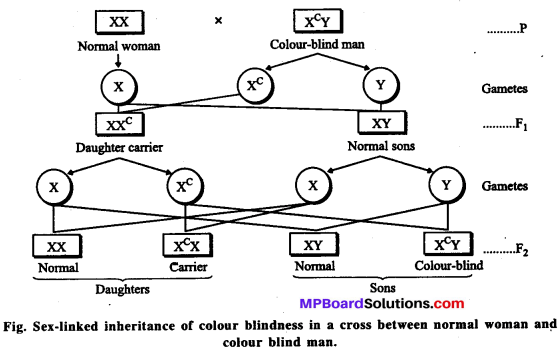
Question 7.
What is Down’s Syndrome?
Answer:
Down’s Syndrome: It is a common human karyotype in which trisomy occur at 21st chromosome. This type of person contains 47 chromosomes. It was first studied by Down (1866) and was popularly known as Mongolian idiocy because the facial features of persons suffering from Down’s syndrome resembled Mongolians. They have broad forehead, flat hands, short neck, projecting lips, stubby fingers and long extending tongue. The Mongoloid individuals are feeble minded and their mental age never exceeds to those of six to seven year’s old children.
Question 8.
Write Differences between Genotype and Phenotype.
Answer:
Differences between Genotype and Phenotype:
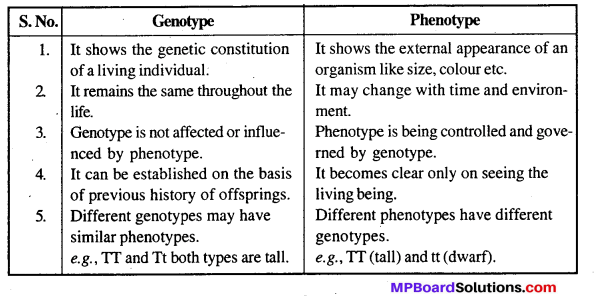
Question 9.
What are plasmids ? Describe its characters.
Answer:
Plasmids : Plasmids are extrachromosomal, extranuclear, self-replicating, covalently closed DNA molecules. These plasmids also play an important role in the transmission of hereditary characters. Plasmids are generally found in bacterial cell in addition to bacterial chromosome. The discoverer of plasmid are William Hays and Lederberg.
Characters of plasmids:
- Plasmids are extranuclear DNA molecules.
- These are smaller than chromosomes.
- These possess the capacity of self-replication.
- They can transfer the genes from donor to recipient cells, they act as the vector molecule of DNA.
- They have a capacity of integration with host DNA hence, it is used in genetic engineering.
Question 10.
Give the structure of E. coli chromosome.
Answer:
Isolated E. coli chromosomes display many individually super coiled loops emanating from a central region. These super coiled loops were hypothesized to be topological domains. These domains are sufficient to generate the observed precision of E. coli chromosome structure. Its chromosomal DNA has been completely sequenced by lab researchers. E. coli has a single chromosome with about 4,600 kb, about 4,300 potential coding sequences and only about 1,800 known E. coli proteins.
Question 11.
What do you understand by reciprocal cross ?
Answer:
Reciprocal cross : A set of two reciprocal crosses means that the same two parents are used in two experiment in such a way that:
- In one experiment, ‘A’ is used as the female parent and ‘B’ is used as the male parent.
- In the other experiment, ‘A’ will be the male parent and ‘B’ the female parent.
Question 12.
What is modifier gene?
Answer:
Modifier genes, instead of making the effects of another gene. A gene can modify the expression of a second gene. In mice, coat colour is controlled by the B gene. THeB allele conditions black coat colour and is dominant to the b allele that produces a brown coat.
Question 13.
What do you understand by Multiple allele? Explain it with example.
Answer:
Multiple allele : There are two alternative forms of each trait for the seven pairs of contrasting characters studied by Mendel. It means that there are two alleles for each trait. The first allele will be dominant and other will be recessive. But further studies show that, there are two or more alternative forms of a gene or allele, which are known as multiple alleles.
Example : (i) The skin colour of rabbit is due to the presence of four alleles of a gene.
(ii) A well known example of multiple allele is ABO blood type in human beings. The four human blood groups ‘A’, ‘B’ ‘AB’ and ‘O’ are the four phenotypes for this trait. Persons having ‘A’ blood group have ‘A’ type of glycoprotein (antigen) coating the red blood cells and persons having ‘B’ blood group have ‘B’ type of glycoprotein (antigen) coating the red blood cells. Persons having ‘AB’ blood group have both type of glycoproteins i.e., ‘A’ and ‘B’ antigens coating the red blood cells, while persons having ‘O’ blood group do not have any glycoprotein on R.B.Cs.
![]()
Question 14.
Describe the causes of hereditary variation.
Or
Why does hereditary variations originate ?
Answer:
Any change in the structure of gene of an organism will produce heritable variations. The chief causes of these variations are as follows :
(i) Genetic recombination : The exchange of chromosomal segments of genes takes place during reduction division which causes recombination of genes. These recombinant organisms fuse to form zygote. The genetic structure of these zygotes is different from their parents. Adults formed from this zygote will show variations.
(ii) Changes in the number of chromosomes : Changes in the number of chromosomes will also cause genetic variations, e.g., modern varieties of wheat contain 16,21 and 42 chromosomes. These varieties are produced from its parents having only 7 chromosomes.
(iii) Changes in the structure of genes : Changes in the structure of gene will also cause genetic variations, e.g., 30 variety of wheat is the best example of genetic variations. Like this, if any changes in the genes of human being which are related with pigment production, will inhibit the production of these pigments and thus man become albino.
Question 15.
Explain recessive epistasis with example.
Answer:
Recessive epistasis (9: 3 :4): In case of recessive epistasis, the epistatic gene is recessive to its own allele. Thus, in this condition, the epistatic gene can have its inhibiting influence only when it is in homozygous condition.
The inheritance of body colour in mice is an example of recessive epistasis. It may have three body colours i.e., agouti, coloured and albino. The agouti body colour is controlled by a dominant gene ‘A’. Another dominant gene ‘C’ gives coloured body only in the absence of dominant ‘A’ gene. The expression of agouti body colour by gene ‘C’ is inhibited by recessive gene ‘C’. Therefore, even in the presence of ‘A’ gene, the mice develop albino body colour if recessive genes ‘CC’ are present.
Question 16.
Why are the women normally carrier of sex-linked diseases ? Write with example.
Or
Men are generally suffering from colour-blindness but women are only carriers pf this disease. Explain the reason.
Answer:
The gene for colour-blindness is recessive and carried by X-chromosomes. A colour-blind man has a single recessive gene (XCY). The gene for normal vision is dominant. When sex chromosomes (X) of a man contains genes for colour-blindness (XC), they express itself and produce colour-blindness in them. A carrier woman contains one recessive gene which remains suppressed due to presence of the dominant gene of normal vision on the other sex chromosomes (XCX). These women play important role in the conduction of genes of colour-blindness. Hence, they are carrier (XCX). Women become colour-blind only when its both chromosomes contain the genes of colour-blindness (XCXC).
Question 17.
What is Turner’s Syndrome?
Answer:
Turner’s Syndrome: It is a disorder arising from chromosomal abnormalities. The cells of a person suffering from this disease contain 45 chromosomes (44 A + X) only. Cytologicaily, they can be recognized by presence of only one X-chromosome (XO female). They are female in general appearance with underdeveloped breasts, broad chest, webbed neck, low set ears, poorly developed ovaries. They are sterile females, often short and of subnormal intelligence.
Question 18.
When a haemophilic man is married with a normal woman then workout the progeny of these parents with the help of diagram only.
Answer:
When a haemophilic man is married with a normal woman, all sons will be normal whereas daughters will be carrier.
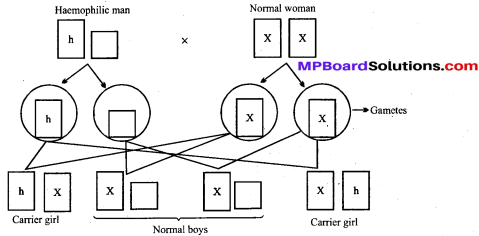
Fig. Offspring of haemophilic man and normal woman.
Question 19.
Why human males are generally suffering from baldness but woman are not suffering from it ?
Answer:
The genes responsible for baldness are found in autosomes but are expressed by sex-linked genes. The baldness is also caused due to irradiation, abnormal functioning of thyroid gland and abnormality in heredity. Genetical baldness depends upon an autosomal allelomorph (Bb). When ‘BB’ is occurred in the form of dominant homozygous then man and woman both suffer from this disease whereas it occurs in heterozygous stage (Bb) in man only because a male hormone is required for their development, hence woman does not suffer from baldness. Baldness is not expressed in recessive homozygous stage (bb).
Question 20.
Describe the inheritance of colour-blindness in the offspring of a colour-blind man and carrier woman with the help of suitable ray diagram.
Answer:
When a colour-blind man is married with a carrier woman, 25% boys will be colour-blind and 25% boys will be normal whereas 25% girls will be colour-blind and 25% girls offspring become carrier of colour-blindness. In other words, we can say that 50% offspring would be colour-blind, 25% normal and remaining 25% offspring will be carrier of colour-blindness.
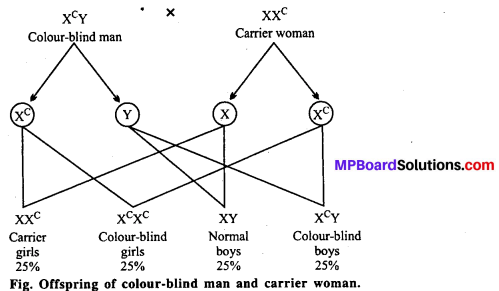
![]()
Question 21.
Explain the inheritance of haemophilia when a haemophilic woman is married with normal man with the help of diagram.
Answer:
When a haemophilic woman is married with a normal man, all the boys offspring will be haemophilic whereas all the girls offspring will be carrier of haemophilia. In other words, 50% offsprings will be haemophilic and 50% offsprings will be carrier.
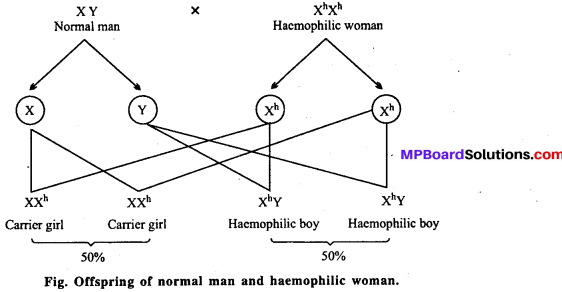
Question 22.
What is Klinefelter’s syndrome ? Also describe their symptoms.
Answer:
Klinefelter’s syndrome: It is a sex chromosomal syndrome. It is found only in men. They possess 47 chromosomes in their cells (22 pairs autosomes + XXY sex chromosomes). One extra X chromosome is found in them, thus, there is Trisomy in sex-chromosome.
Principles of Inheritance and Variation Long Answer Type Questions
Question 1.
Write down the law of segregation.
Or
Describe Mendel’s law of segregation with example.
Answer:
According to law of segregation, two genes of a character separate and get distributed randomly to different gametes and then to different offspring as per the law of probability. In other words, genes for each trait segregate without mixing.
When a cross is made between pure tall pea plant and dwarf pea plant, it gives rise to tall plant in the F1 generation. On self-breeding both tall and dwarf plants appear in F2 generation in the ratio of 3 : 1. This ratio can be achieved only if the two factors separate at the time of gamete formation and only one factor passes into gamete. Therefore, this law is also called as law of purity of gametes.
Question 2.
Explain Complementary gene (9:7) with example.
Answer:
Complementary genes (9:7): The complementary genes are the two pairs of non-allelic genes which are present on separate loci and interact to produce only one phenotypic trait but either of them if present alone produces the phenotypic trait in the absence of other.
The example of complementary gene interaction was provided by Bateson and Punnet in sweet pea (Lathyrus odoratus). He demonstrated that two dominant genes ‘C’ and ‘P’ are responsible for the development of purple coloured flowers in a plant of sweet pea. The dominant gene ‘P’ or ‘C’ in homozygous (PP and CC) and heterozygous (Pp and Cc) state are unable to produce their effect if they are present alone. They observed that when two white flowered plants are crossed with each other, the F1have coloured flowers.
This is due to the fact that crossing between two white flowered plants brought together two non-allelic dominant genes in Ft. On intercrossing, these Fi progenies produced coloured and white flowered plants in 9:7 ratio (Fig.).
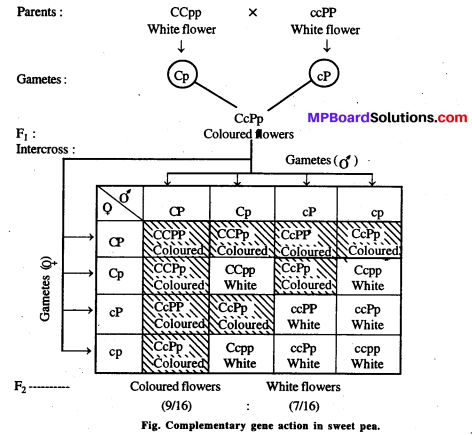

Question 3.
Explain the Law of Independent Assortment of Characters.
Answer:
The gametes and zygotes usually carry several chromosomes which are different in appearance and perhaps in contents. The genotype consists of many pairs of genes. Although chromosomes were not known to Mendel yet he felt the need of finding out how different characters would behave in relation to each other in their passing from generation to generation. This also could be demonstrated with two pairs of opposite characters. Such a cross which involves two character differences separable in inheritance is termed as a dihybrid cross. For example, taking parents round yellow pea and a wrinkled green pea (Fig.).
Round, yellow (RY) : Dominant characters Wrinkled,
green (ry) : Recessive characters.
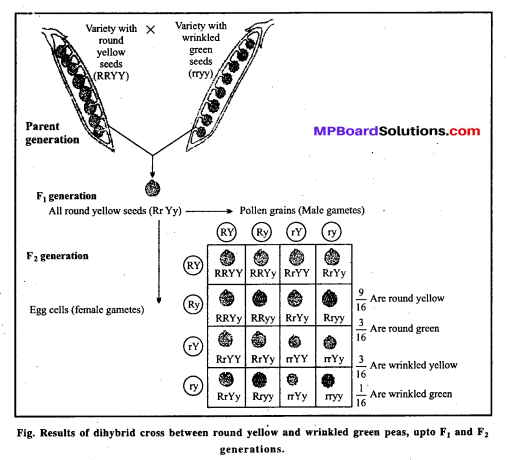
Question 4.
What is chromosomal theory of inheritance ?
Answer:
In 1902, Sutton and Boveri proposed a theory to explain inheritance of characters. This theory is known as chromosomal theory of inheritance.
The main points of this theory are as follows :
- Chromosomes and factors are found in pairs in diploid cells.
- Chromosomes and factors get’separated during the formation of gametes.
- During transmission of characters only one chromosome and factor is transmitted to offspring.
- Pairing between homologous chromosomes and factor occurs after fertilization.
Question 5.
What is crossing over ?
Or
Explain crossing over.
Or
Write the process of crossing over with diagram that occurs during meiosis.
Answer:
Exchange of chromosomal segments between two homologous chromosomes during diplotene of meiosis I division is called as crossing over. When homologous chromosomes tend to start their separation due to repulsion during diplotene, they are bounded
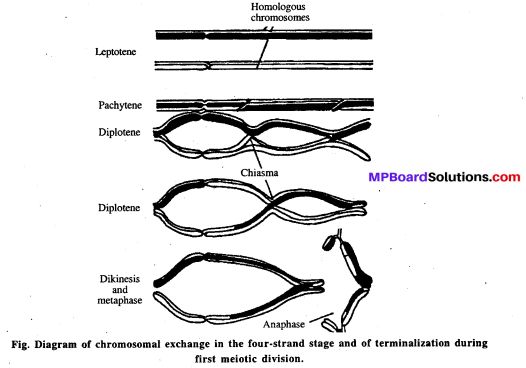
In some places. These places are called Chiasmata. Due to the process of terminalization chiasmata start to move along the length of the chromosome from the centromere. The terminalization of chiasmata will result in the formation of ‘X’-shaped configuration in which breakage of chromosomal segments takes place, then these segments are reunited in a manner in which the segments of non-sister chromosomes are exchanged. This exchange of chromosomal segments or genes of homologous chromosomes is termed as crossing over. This process is very important because it originates new characters and causes variations in the organisms.
![]()
Question 6.
Explain sex-linkage by giving example of haemophilia.
Or
What is sex-linkage? Describe the inheritance of haemophilia on the basis qf sex linkage.
What is sex-linkage? Explain with suitable example.
Answer:
Genes that are formed on sex chromosomes and are inherited together are called linked genes and the process is called sex-linked inheritance of sex-linkage.
Inheritance of haemophilia in man : Haemophilia is a sex-linked disease in which patient losses the capacity of blood clotting during bleeding. This disease is caused by a recessive gene present on the X-chromosomes (Xh). A man possessing a single recessive gene suffers from the disease because the Y-chromosome does not contain any gene (XhY). A carrier women shall have only one gene of the disease (XXh). She does not suffer from the disease because of the presence of the normal gene on the second sex chromosomes.
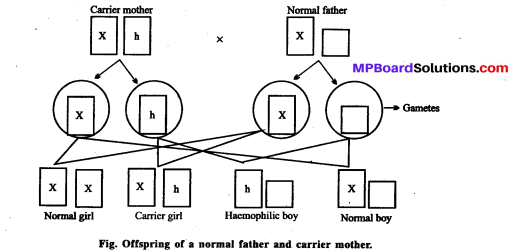
We can understand the process of inheritance of haemophilia by the following examples:
1. Inheritance of haemophilia in offspring of a normal father and carrier mother: 50%
children (25% boys + 25% girls) of these parents are normal, 25% boys are haemophilic and 25% girls are carrier of this disease.
2. Inheritance of haemophilia in the offspring of haemophilic man and normal woman : All the boys of these parents will be normal while all the girls will be carrier of the disease.
3. Inheritance of haemophilia in the offspring of normal man and haemophilic woman : All die boys of these parents will be haemophilic and all the girls will be carrier of the disease.
4. Inheritance ofhaemophilia in the offspring ofhaemophilic man and carrier woman : The 25% boys of this parents will be haemophilic and 25% boys will be normal while 25% girls will be haemophilic and remaining 25% girls will be carrier of the disease.
Question 7.
What is linkage? It is of how many types?
Answer:
Linkage : The tendency of genes inherited together, without independent assortment is called linkage and such genes are linked genes. Such genes are closely situated showing a strong attraction between them. Linkage always reduces the changes of crossing over. All those genes which are located in the single chromosome from one linkage
group. The linkage groups correspond to the haploid number of chromosomes of a species or number of chromosomes pairs. Thus, the linkage groups in maize would be 10,7 in pea, 4 in Drosophila, 23 in man etc.
Types of Linkages :
T.H. Morgan along with Castle working on Drosophila discovered the following types of linkage:
1. Complete linkage : It is the phenomenon in which parental combination of characters appear together for two or more generations continuously.
Example: Genes for bent wings and shaven bristles in Drosophila melanogaster.
2. Incomplete linkage : In this phenomenon the linked genes may remain together for one generation only and have chances of separation in subsequent generation, because of crossing over.
Example : Genes for grey body and long wings characters.
Question 8.
What is gene mutation ? Explain the causes of gene mutation.
Answer:
Gene mutation : Genes are responsible for the transmission of hereditary characters from generation to generation. Sometimes few sudden changes in the structure and arrangement of genes take place which result in the production of new characters. These sudden changes in genes are called as gene mutation.
Causes of gene mutation :
- According to Beadle and Tatum, mutations occurs due to the physical and chemical changes in genes during reproduction.
- According to Rasowsky, X-rays also cause mutation.
- According to Muller, radioactive radiations also cause mutations.
- According to Guber and Smith, some antibiotics also cause mutation.
- Sudden changes during reproduction also cause mutation.
- Changes in the number of chromosomes.
Question 9.
What is incomplete linkage and complete linkage ?
Answer:
When there are chances of separation of linked genes, it is called incomplete linkage. In this type of linkage, genes are situated at distance. During crossing over in meiosis, probability of separation of genes increases. In maize incomplete linkage is found.
When there are no chances of separation of linked genes, it is called complete linkage. Complete linkage takes place due to the non-break in the gene combination, situated on any chromosome. It is found is Drosophila and other insects.
Question 10.
Explain the types of sex chromosomes.
Answer:
Mainly sex chromosomes are of two types :
(A) Autosomes
(B) Sex chromosomes or Allosomes.
(A) Autosomes : That carry genes for body characters and general physiological activities. The two members of each homologous pair are similar in shape and size.
(B) Sex chromosomes : That carry genes for sex. A pair of them determines the sex. They are of following types :
1. XX and XY method of sex determination: In majority of animals female have XX sex-chromosome and male have XY. The females are homogametic and produce ova of one type of X chromosome. Male are heterogametic, they produce two types of sperms X and Y chromosomes. It means sex chromosomes in female are homomorphic and of male are heteromorphic.
Examples: Drosophila and man.
2. XX-XO method of sex determination: In this case female have two homomorphic sex chromosomes XX. They produce all ovas with X chromosomes. The males have only one X chromosomes, there is no Y chromosome. Example: Birds, Butterflies, Fishes and etc.
![]()
Question 11.
Explain the chromosomal theory of linkage.
Answer:
Chromosomal theory of linkage was produced by Morgan and Castle in 1911. The main points of this hypothesis are :
- Linked genes are found on a chromosome.
- The strength of linkage depends upon the distance between genes.
- Two nearest genes exhibit linkage while genes exhibit crossing over.
- All linked genes are found on a particular place on the chromosomes and are arranged in a linear fashion.
Question 12.
Explain the inheritance of colour-blindness when the man is blind and woman is normal.
Answer:
Colour blindness : It is a genetic disease. It is an inability to distinguish red from green. The recessive gene C, for the trait is carried by ‘X’ chromosomes, ‘Y’ chromosome has no corresponding gene. A single gene C, on ‘X’ chromosome is sufficient to express itself in the male. Female are generally carrier of the disease in such cases.
Example : The inheritance of colour-blindness in the offspring of a normal woman and colour blind man are as follow:
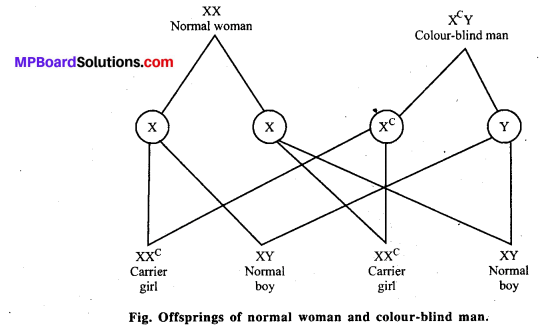
Ratio : 50% offsprings are carrier and 50% offsprings are normal. In other words all the girls will be carrier of colour blindness whereas all the boys will be normal.